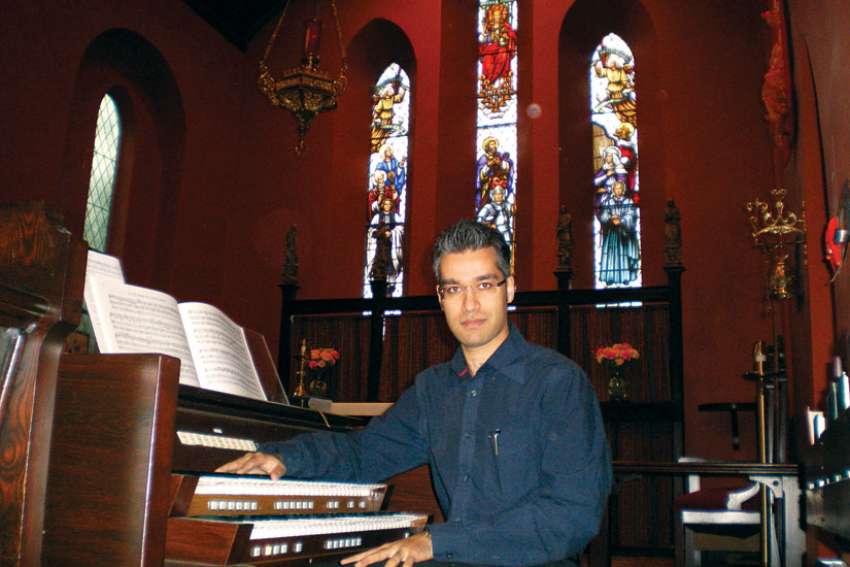The ethereal music of Gregorian Chant is no longer commonplace in a modern Catholic church, but every Saturday at 5 p.m., hundreds of people from across the Archdiocese of Toronto flock to the church to hear the noble music.
For 10 years, the choir has been a call back to what choir director Surinder Mundra has seen as a lost form in the modern Church.
“What I think is very, very important about this music is that it also is an expression of the times and people were entrenched,” he said. “Their Catholic faith was deeply a part of every facet of their life and even in their artistic expression.”
Pope St. Gregory the Great has been credited with inventing Gregorian chant, but scholars believe that it rose from the blending of two previous styles of chant, the Roman chant and the Gallican chant during the eighth and ninth centuries.
The Gregorian chant is traditionally sung by choirs of men and boys in churches, or by men and women of religious orders in their chapels. It is sung in a monophonic style, meaning the melody is in unison.
“Because it’s monophonic and it has one particular line, the emphasis is that everyone sings in one voice,” said Mundra. “Every one is singing the official text of the Church from the Scripture. It’s universal in that it’s sung in Latin... And it’s unchanging. I think that’s what makes it really, really beautiful.”
Mundra admits that there is still a certain beauty to modern Church music, but because Gregorian chant is based on Scripture, it brings a different quality to the experience of Mass.
“The inspiration behind it is that you’re writing music that is set to Scripture and the soaring melodies have a particular reason, as well. The modes have particular feelings,” he said.
“When you start to unpack this, when you start to explore the wonderful treasury of the Church through the chants, you begin to discover why it should have a pride and place more so than any of the modern kinds of renditions.”
Mundra’s passion for this sacred music of the Church is what inspired him to start a Gregorian choir.
Mundra, 36, is the assistant director of the Toronto Concert Orchestra under Maestro Kerry Stratton, as well as accompanist and boys’ choir conductor for the Mississauga Children’s Choir. He has also worked as a rehearsal accompanist for the Canadian National Ballet Company and performed at Roy Thomson Hall many times.
 Members of the St. Patrick's Gregorian Choir. (Photo courtesy of Surinder Mundra)
Members of the St. Patrick's Gregorian Choir. (Photo courtesy of Surinder Mundra)
Mundra grew up in a family that cultivated his passion for classical music.
He recalls his mother taking him to Mass at St. Michael’s Cathedral as a child and hearing the St. Michael’s Boys Choir. It was a rare opportunity to be exposed to traditional sacred music that local parish churches didn’t have.
“I remember on one occasion and during the sermon they had played ‘What a Wonderful World’ on the PA system,” said Mundra. “And when I left church I would go to my car and listen to (classical) radio, I would hear beautiful polyphonic music and Church music. As I started growing up, I started wondering what is the actual liturgical music of the Church?”
In 2006, the 26-year-old Mundra decided to form a choir he hoped would trigger new interest in Gregorian chant and other traditional sacred music. He was already working at St. Patrick’s as an organist, so when he approached the Redemptorist Fathers about the idea of forming a Gregorian choir, they gave him their full support.
“Because I think it’s in the centre of downtown, there’s a lot of suffering that you experience, especially with the homeless,” said Mundra. “I think that being aware of that, the Redemptorists are very open and very welcoming to a great deal of diversity….v So when I proposed starting it, they had absolutely no issues whatsoever and I could probably say that if I suggested doing it at another church, it probably wouldn’t have happened.”
Having a weekly Mass in the traditional Latin rite has been a gift not just to the congregation, but to the priests that celebrate it. Mundra said visiting priests and deacons from across the archdiocese often come to St. Patrick’s to have the experience of celebrating the Mass sung in full.
“We believe in a religion that is thousands of years old ... but it is still relevant today. The music, although it comes from a particular time, it is calling out attention to this time that happened before our time,” said Mundra.
“I think that’s what makes the Gregorian chant special, as well, because although it is old, we could probably be very sure that a lot of the saints were very familiar with this music. And I think that continuity brings us closer in a certain way, in a very tangible way to our Catholic heritage.”
This music, which was written by monastic priests and nuns, was purposefully inspired for the encounter with the Divine, which is why Mundra said he is not surprised that it has inspired great faith.
Even within the choir, Mundra has seen members find callings to the priesthood and the religious life.
“I don’t think it’s a coincidence,” he said. “The music that we’re singing is not simply aesthetically beautiful. The ultimate aim for the choir is to bring people to a greater attention to the liturgical action on the altar.”
St. Patrick’s Gregorian Choir is celebrating its 10th anniversary with a special Mass at St. Michael’s Cathedral on Oct. 30 in the presence of Cardinal Thomas Collins.

